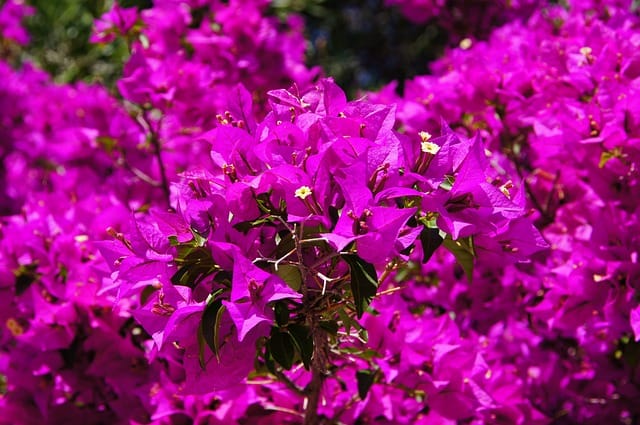How to grow Bougainvillea (Bougainvillea)
The Bougainvillea is a popular and beautiful flowering plant known for its vibrant and showy blooms

In this article:
- Introduction to Bougainvillea
- Choosing the right variety
- Planting location and soil requirements
- Planting Bougainvillea
- Watering needs
- Fertilizing Bougainvillea
- Pruning and training techniques
- Pests and diseases
- Propagation methods
- Winter care tips
- Troubleshooting common issues
- Frequently asked questions
- Conclusion
Introduction to Bougainvillea
The Bougainvillea is a popular and beautiful flowering plant known for its vibrant and showy blooms. Native to Brazil, it belongs to the Nyctaginaceae family. Bougainvillea is a versatile plant that can be grown as a climber, trained as a shrub, or used as a hanging basket plant.
Choosing the right variety
Before planting a Bougainvillea, it is essential to choose the right variety that suits your climate and space. Bougainvillea comes in various colors like red, pink, orange, yellow, and purple. Some popular varieties include 'Barbara Karst,' 'Double Delight,' 'Vera Purple,' and 'Snow White.'
Planting location and soil requirements
Bougainvillea thrives in full sun, so it is crucial to choose a planting location that receives at least 6 hours of direct sunlight per day. The soil should be well-draining, fertile, and slightly acidic with a pH level between 5.5 and 6.5.
Planting Bougainvillea
Begin by preparing the planting hole at least twice the size of the root ball of the Bougainvillea. Gently remove the plant from its nursery container and place it in the hole. Backfill the hole with soil, ensuring that the plant is at the same level as it was in the container. Water thoroughly after planting to settle the soil.
Watering needs
Bougainvillea is a drought-tolerant plant once established, but it requires regular watering during its initial growth phase. Water the plant deeply once or twice a week, allowing the top few inches of soil to dry out between watering. Avoid overwatering, as it can lead to root rot.
Fertilizing Bougainvillea
Feed your Bougainvillea every 4-6 weeks during the growing season with a balanced fertilizer. Choose a fertilizer with a higher middle number (phosphorus) to encourage blooming. Avoid excessive nitrogen, as it can promote foliage growth at the expense of flowers.
Pruning and training techniques
Regular pruning is essential to keep Bougainvillea in good shape and promote flowering. Prune after each blooming cycle by removing dead or diseased branches and maintaining the desired shape. You can also train Bougainvillea as a climber by tying or attaching it to a support structure, such as a trellis or fence.
Pests and diseases
Bougainvillea is generally a hardy plant but can be susceptible to pests such as aphids, mealybugs, and caterpillars. Keep an eye out for any signs of infestation and treat accordingly with insecticidal soap or neem oil. Common diseases that affect Bougainvillea include powdery mildew, leaf spot, and root rot. Maintain good air circulation and avoid overwatering to prevent the occurrence of these diseases.
Propagation methods
Bougainvillea can be propagated through cuttings or seeds. Take 6-8 inch semi-hardwood cuttings from a healthy Bougainvillea plant and dip the cut ends in rooting hormone before planting them in a well-draining rooting medium. Keep the cuttings warm and moist until they develop roots. Alternatively, collect mature Bougainvillea seeds, scarify them, and plant them in a seed-starting mix.
Winter care tips
In colder climates, Bougainvillea needs protection during winter. If you live in an area where temperatures drop below freezing, consider growing Bougainvillea in containers so that you can bring them indoors during winter. Place them in a sunny location and reduce watering frequency during the dormant period.
Troubleshooting common issues
Some common issues that Bougainvillea may encounter include yellowing leaves, lack of flowers, or stunted growth. These problems can be caused by factors such as nutrient deficiencies, improper watering, or inadequate sunlight. By addressing these issues and providing optimal care, you can help your Bougainvillea thrive.
Frequently asked questions
Q: How often should I fertilize Bougainvillea?
A: Bougainvillea should be fertilized every 4-6 weeks during the growing season.
Q: Can I grow Bougainvillea in a cold climate?
A: Bougainvillea can be grown in cold climates as long as it is protected from frost and freezing temperatures.
Q: How tall can Bougainvillea grow?
A: Bougainvillea can reach a height of 20-30 feet with proper care and training.
Conclusion
With its stunning colors and ability to thrive in various climates, the Bougainvillea is a delightful addition to any garden or landscape. By following the guidelines mentioned in this article, you can successfully grow and care for this beautiful climber. Enjoy the vibrant blooms and the joy they bring to your outdoor space!
